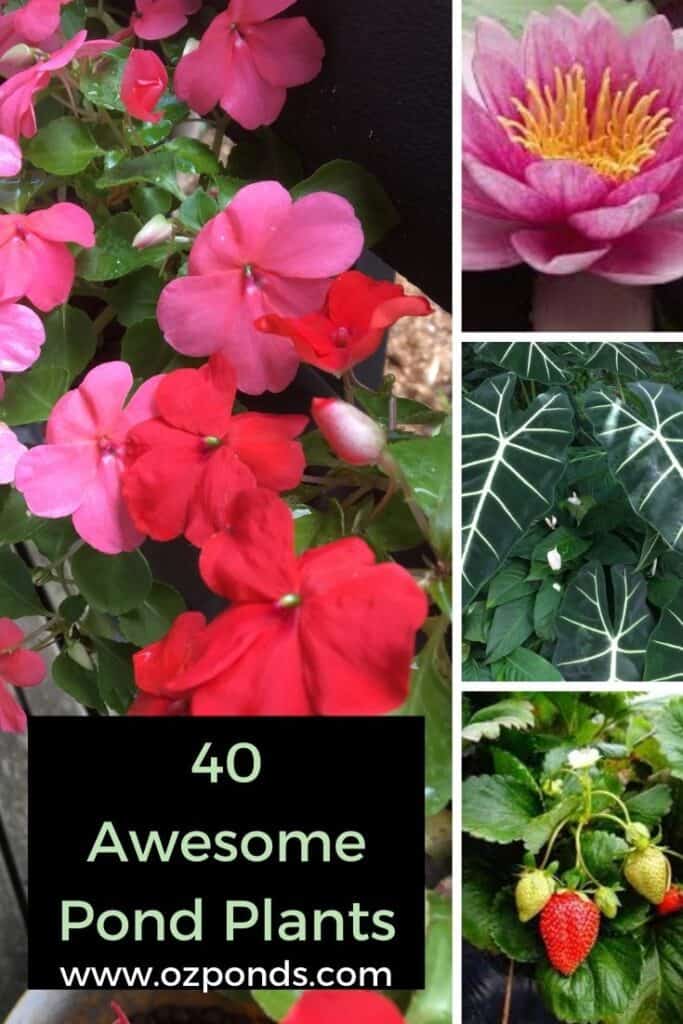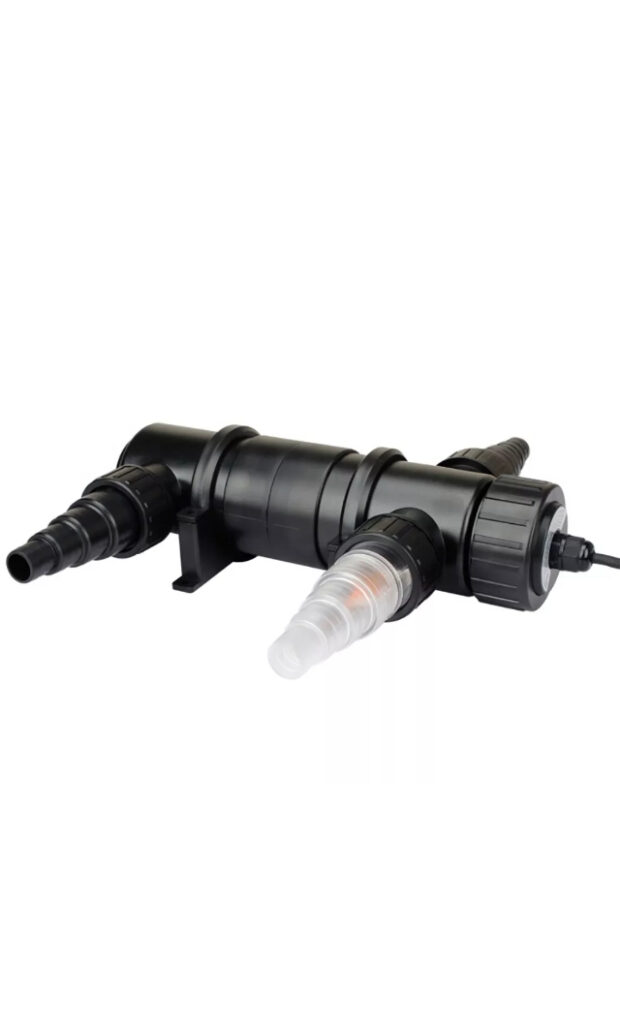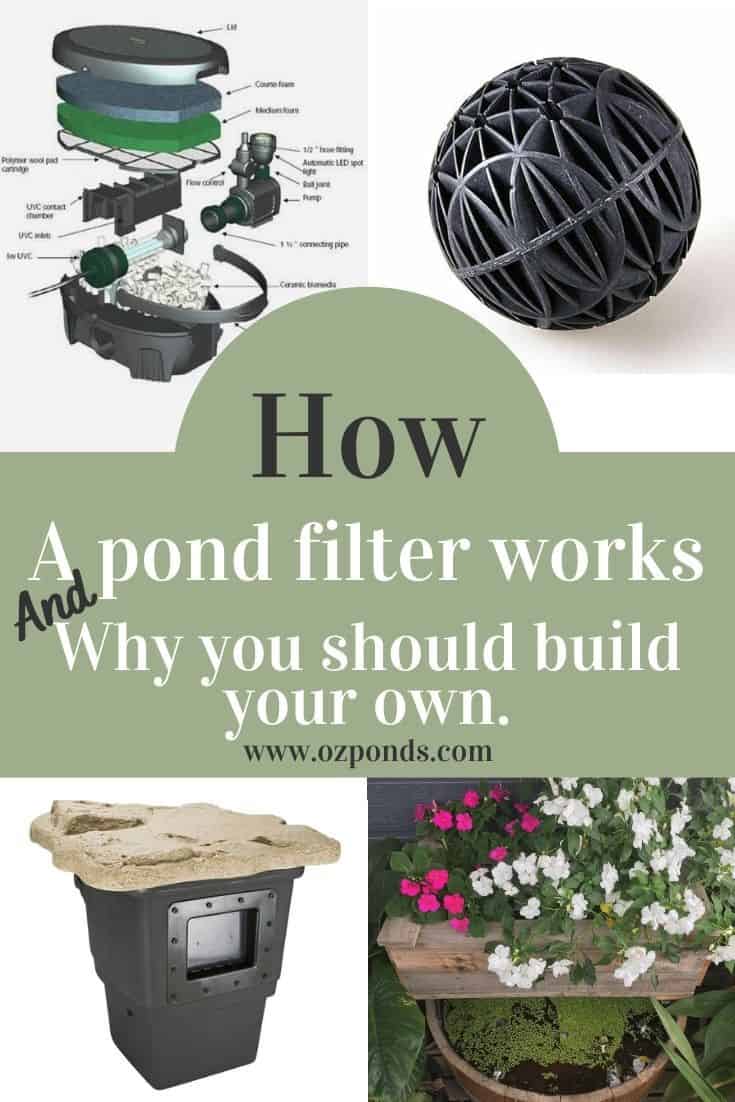There are 4 methods of filtering pond water. Biological, mechanical, plants and chemical.
Now i know it sounds technical, but its not!
Once you understand these basics of pond filters, you’ll be able to build or maintain the perfect filter for whatever pond you own.
Biological
This is the most important element of pond filtration and occurs in every single pond. Biological simply means this filter is living!
The simple explanation for this type of filtration is that- beneficial bacteria colonise your pond and convert harmful chemicals into friendly chemicals. These bacteria are of course living and they are the filter.
I know. I know. Bacteria in my pond!? That sounds bad!
Well it’s not!
These bacteria colonies process fish waste and turn it into plant food. Without the bacteria toxic gasses and chemicals will build up in the water and kill your pond fish.
This process is called the nitrogen cycle. Every pond owner/fish owner should understand this cycle! It’s the backbone of any filter system. For those that want a quick guide to the nitrogen cycle– click the link and read the beginners guide i created.
Now the good news is that beneficial or nitrifying bacteria are all around us and will naturally colonise your pond and filter. All that they require in return is a safe environment.
This environment needs to be chlorine free (Chlorine kills bacteria), constantly wet and the water needs dissolved oxygen.
Basically every surface of your pond!
So the trick to increasing the amount of beneficial bacteria within the pond or filter is to add more surface area.
Within the pond itself this can be the addition of rocks and pebbles. Boosting surface area within the filter can be accomplished using special filter media like ceramic noodles, bio balls or K-1 filter media.
All these provide large surface areas for bacteria, yet take up very little physical space.
Biological filter summary
- So in a nut-shell, biological filtration is the bees knees!
- It relies on the presence of bacteria to purify the water.
- The bacteria needs suitable surfaces to thrive.
Mechanical
Filtering the pond water mechanically is the second most important method of pond filtration. Mechanical filtration simply means that the water is purified by physically removing contaminants.
You scooping leaves out of your pond is a type of mechanical filter. But there are better ways!
Things like filter pads and sponges are great at removing fine particles from the water. Pond skimmers are fantastic at pulling in floating items like leaves and pollen.
All the items that fall into your pond will begin to decay. As they decay they release gasses and nutrients. The beneficial bacteria will transform these gasses and nutrients into plant friendly compounds.
And here’s the problem (we cant rely on mechanical filtration alone).
Algae is a plant! and it will gladly start growing and consuming these compounds. From a water quality perspective this is completely natural, and nothing to be alarmed about. However i understand it doesn’t look very nice to see a green pond!
But if we incorporate good levels of mechanical filtration along with our biological filtration we can remove much of the solid waste that will be transformed into food for the algae.
The easiest and laziest way to mechanically filter your pond is to incorporate a pond skimmer. The skimmer will suck in the majority of waste and all you need to do is empty the basket and wash off some filter pads.
Mechanical filter summary
- Mechanical filtration is the physical removal of contaminants in the water.
- Removing debris from the pond will help prevent algae.
- Pond skimmers and filter pads or sponges are the best mechanical filters.
Plants
Plants of course are an amazing natural filter. Without them we cannot survive. They filter the carbon dioxide and provide us with oxygen.
In a pond environment they consume nutrients and provide more surface area for the beneficial bacteria.
Ponds are an incredibly adaptable environment and can almost always find the appropriate ecological balance.
In a pond with excessive nutrients nature will take control and algae will grow abundantly. But if we incorporate pond plants in our filter strategy we can remove many of the nutrients.
Basically out competing the algae!
When using plants as part of the filtration system select plants that grow in different zones of the pond.
For some pond plant inspiration read my article on 40 awesome pond plants.

For example
- Plants that grow on the margins of the pond- these plants like to have their foliage out of the water but their roots in the water.
- Floating plants- these will provide shade and are generally fast growing. Thus able to remove nutrients from the water quickly.
- Submerged plants- these will produce oxygen under the water and consume nutrients. Remember the nitrifying bacterias perform best in oxygen rich water.
- Another tip i like to give people is to use plants that perform at different times of the year. This means plants should be sucking up nutrients no matter what season it is.
Plants summary
- Plants are an awesome complement to all filtration systems.
- Removing nutrients will also prevent algae.
- Using a diverse range of plants will provide best results.
Chemical
Chemical filtration refers to the use of certain compounds to improve water quality or clarity.
It’s not a method of filtration i personally use on my ponds, as i find that if the biological, mechanical and plant filtration aspects of filtration are functioning chemical filtration isn’t required.
In saying that there are certainly situations where chemical filtration is needed.
Heres some examples:
The most common form of chemical filtration in a pond is probably the UV light. A UV light uses light to eliminate single cell algae (the algae that makes a pond go green). UV lights may be required in ponds with high fish numbers.

A more recent addition to the war on pond algae has been the ioniser. These little gadgets release copper ions into the water that will destroy the cells of algae. The dead algae will then be removed by the mechanical filtration.
Another common chemical filter is the use of carbon. Carbon can be used to absorb tiny particles that discolour pond water like suspended clay particles or tannins( tea coloured water).
Chemical filtration doesn’t actually enhance the water quality, it merely improves clarity. The biological filter is most responsible for overall water health.
Chemical summary
- Chemical filtration uses compounds to improve water clarity.
- Getting the biological, mechanical and plant mix right is far more important.
- Chemical filters don’t actually improve water quality.
Do you need a pond filter?
Inadvertently every pond will have a filter!
Those awesome beneficial bacteria and micro-organisms will colonise every piece of wet realestate within the pond. Liner, rocks, mud, plant roots, they all provide habitat for the bacteria.
As i mentioned above the bacteria are the backbone of the biological filtration system, which is the most important.
The question is: “Do you have enough beneficial bacteria (or biological filtration)?”
If your pond is green, smells or has sick fish the answer is-No!
If your pond has clear water, no smell and healthy fish the answer is-Yes!
I know this seems really simple and at the end of the day it is!
There is no one size fits all answer to pond filtration as every pond is different. Climates are different. Amount of fish in a pond is different. Sun vs shade. How often the water is circulated.
All these will effect the filtration needs of a pond.
The single biggest variable is the amount of fish in a pond. If you desire or have a densely populated fish pond you most defiantly need filtration.
But on the other hand I’ve had ponds with no fish and no filter, yet perfect water quality.
Adding filtration isn’t hard, there are many plug and play options on the market. They do require regular maintenance but have a minimal size footprint. They also generally incorporate biological, mechanical and chemical filtration all in the one unit.
If you’re interested in a more natural and lazy method of filtration keep reading.
What’s the best pond filter?
Without hesitation a bog or wetland filter provides the best pond filtration!
Bogs and wetlands are remarkable natural filters. They provide biological filtration, mechanical filtration and plants! Those are the big 3 for pristine water.
- A bog or wetland filter can be added to any sized pond.
- They are completely natural and require no extra pumps.
- Require very little maintenance.
- Can be easily added onto an existing pond.
- Easy diy project.
To learn how to build a wetland bog filter click the link to read our article. You also might like to learn how to size a wetland or bog filter.
Of course some of you will prefer to buy a ready made filter off the shelf. There are two main choices. Gravity and pressurised filters. Below are some of the more reputable brands.
Gravity filters will handle the most amount of waste. So are therefore better for densely stocked ponds.
Pressurised filters aren’t as large, but are easily hidden and can be cleaned without getting your hands wet!
Often both will include uv filters built within the unit itself.
Subscribe
We often receive special offers and discounts from pond product suppliers and distributors. We love passing these savings onto our readers.
If you would like to receive these offers direct to your inbox, sign up using the button below.

